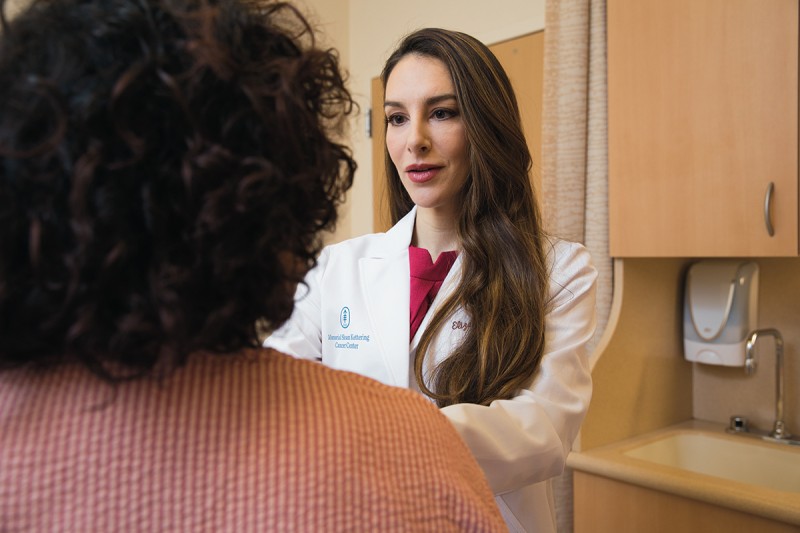
You might know how to check yourself for breast lumps, but do you know what to do if you find one? Memorial Sloan Kettering Cancer Center (MSK) breast medical oncologist Elizabeth Comen offers these recommendations.
First, don’t panic if you find a lump or change in your breast.
It’s natural to worry if you feel something new in your breast. But Dr. Comen says: “It’s extremely common for women of all ages to find lumps and bumps in their breasts. The majority will turn out to be benign.”
There are many types of breast lumps that aren’t cancer.
Some, like fibroadenomas, are harmless clumps of breast tissue. Some, like cysts, are related to hormones and appear during a woman’s menstrual cycle or if she’s breastfeeding.
It’s not possible to determine what is a cancerous versus a noncancerous lump based on how it feels. Not all breast lumps feel the same. Some breast lumps are hard. Some are soft. Some are painful. Some don’t hurt at all. Some lumps in your breast are mobile, meaning you can move them with your finger, and some aren’t. Sometimes a lump is actually in the armpit or above the breast mound.
Back to topIf you find a lump, see your doctor for a breast physical exam.
Dr. Comen stresses the importance of getting a good physical exam from either your primary doctor or gynecologist. That means your doctor should do more than just feel the lump in your breast. “Make sure they do a full exam of the breast, including around the collarbone and underneath the armpit,” she says. Your doctor should also examine your skin and nipples to look for any changes, and compare your breasts side by side and note any asymmetries.
During your exam, you’ll also want to tell your doctor some additional details, including:
- When and how you found the lump.
- If you’ve noticed any other changes, like nipple discharge or a change in your breast’s color or texture.
- If you have ever had an injury to your breast.
- What hormones, medications, or supplements you take.
- Your family’s history of breast cancer or other cancers.
Ask your doctor about breast imaging, like a mammogram.
“Based on your physical exam, age, and your risk of breast cancer, your doctor will help determine if breast imaging may be appropriate for you,” says Dr. Comen. Usually, screening starts with a mammogram. If it’s inconclusive, your doctor may call you back for additional imaging. But Dr. Comen says that this happens frequently and is not necessarily an indication that anything is wrong.
If your doctor wants a closer look at something — or if you have dense breasts, which makes it harder to see breast tissue on a mammogram — you might also get an ultrasound or MRI. People with a higher risk of breast cancer than the general public, plus a family history of breast cancer, should ask their doctor about getting an MRI.
Back to topTrust your doctor’s recommendation on a biopsy.
In many cases, doctors can tell from a mammogram that a breast lump appears benign. Sometimes, though, doctors may need to do a biopsy to confirm that a lump is benign. That means a doctor will insert a needle into the breast to take a sample of the lump’s cells. You will be awake for the biopsy, and doctors will give you medications to decrease any discomfort or pain.
Being anxious and worried about a breast biopsy is entirely understandable. Most times, biopsies do not show cancer. “The vast majority of the time we biopsy a lump in the breast, it’s not breast cancer,” Dr. Comen says. “We recognize the anxiety that comes with a biopsy. Most of the time, we are doing one just to make sure we’re absolutely positive, above and beyond, that we’re not missing any cancer.”
How To Do a Self-Breast Exam
Dr. Comen recommends that women check their breasts for any changes once a month. She suggests the first of the month so it’s easy to remember, or right after your period if you are menstruating, when breasts are less likely to be tender and lumpy. However, self-exams should not take the place of routine breast cancer screenings from a healthcare professional.
Learn how to perform a self-breast exam.
What if a lump is breast cancer?
In the unlikely event that a breast lump turns out to be cancer, MSK is a leader in caring for people with all forms of the disease. Dr. Comen says.
Recognizing that breast cancer isn’t one-size-fits-all, MSK has special programs in place for treating people with unique subsets of the disease, including inflammatory breast cancer, rare breast cancers like male breast cancer, and breast cancers in young women.
MSK specialists also understand that healthcare goes beyond medicine and are here to support your mental, social, and emotional health as well. Dr. Comen says, “We have a team of experts that is ready to assist and help you on your way.”
Back to top"breast" - Google News
September 20, 2022 at 11:00AM
https://ift.tt/k2Ml9LR
If You Find a Lump in Your Breast, Here’s What To Do Next - On Cancer - Memorial Sloan Kettering
"breast" - Google News
https://ift.tt/qE2DICr
https://ift.tt/ibxLoMN
Bagikan Berita Ini














0 Response to "If You Find a Lump in Your Breast, Here’s What To Do Next - On Cancer - Memorial Sloan Kettering"
Post a Comment